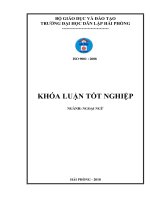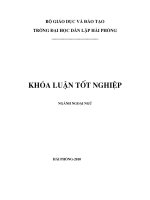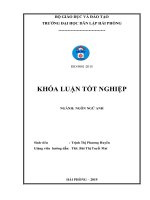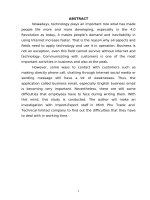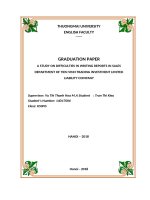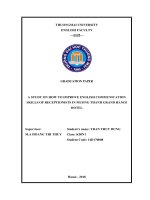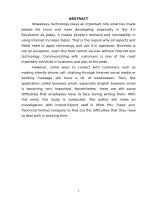A study on difficulties in writing English business email of ImportExport staff in Minh Phu Trade and Technical limited company
Bạn đang xem bản rút gọn của tài liệu. Xem và tải ngay bản đầy đủ của tài liệu tại đây (1.61 MB, 69 trang )
ABSTRACT
Nowadays, technology plays an important role what has made
people life more and more developing, especially in the 4.0
Revolution as today, it makes people’s demand and inevitability in
using Internet increase faster. That is the reason why all aspects and
fields need to apply technology and use it in operation. Business is
not an exception, even this field cannot survive without Internet and
technology. Communicating with customers is one of the most
important activities in business and also at the peak.
However, some ways to contact with customers such as
making directly phone call, chatting through Internet social media or
sending message still have a lot of weaknesses. Thus, the
application called business email, especially English business email
is becoming very important. Nevertheless, there are still some
difficulties that employees have to face during writing them. With
this mind, this study is conducted. The author will make an
investigation with Import-Export staff in Minh Phu Trade and
Technical limited company to find out the difficulties that they have
to deal with in working time.
1
ACKNOWLEDGEMENTS
A completed research would not be done without any
assistance.
Therefore,
the
author
who
conducted
this
study
gratefully gives acknowledgement to the support and motivation in
the duration of doing this paper.
First of all, I would like to express my sincere gratitude and
gratefulness to my supervisor Mrs. Nguyen Thi Bich Ngoc who
helped, supported and encouraged me enthusiastically while I
conducted this graduation paper. Her kindly support and continuous
advice
went
through
the
process
of
the
completion.
Her
encouragement and comments had significantly broadened and
bettered
my
work.
Without
her
inspiration,
motivation
and
instructions, the study would have been impossible to be done
effectively.
Moreover, I would like to express my appreciation to the
Import-Export staff as well as the manager of the department in
Minh Phu Trade and Technical limited company who helped me to
conduct data collection for the study to make it more detailed.
Last but not least, I would like to state my special thanks to
approve to my parents for their endless love, care, assistance and
motivation to me for the whole of my life; my deeply thanks come to
all my friends whose kindly help, care, motivation gave me strength
and lift me up all the trouble for the rest of my life.
2
TABLE OF CONTENTS
ABSTRACT..................................................................................................................i
ACKNOWLEDGEMENTS........................................................................................ii
TABLE OF CONTENTS...........................................................................................iii
LIST OF FIGURES, CHARTS AND TABLES.........................................................v
LIST OF ABBREVIATIONS.....................................................................................vi
CHAPTER 1: OVERVIEW OF THE STUDY..........................................................1
1.1. Rationale...............................................................................................................1
1.2. Previous studies....................................................................................................2
1.3. Aims and objectives of the study.........................................................................4
1.4. Research subjects..................................................................................................4
1.5. Scope of the study.................................................................................................4
1.6. Research methodology.........................................................................................4
1.6.1. Instruments.........................................................................................................5
1.6.2. Data collection procedures.................................................................................6
1.6.3. Data analysis methods........................................................................................6
1.7. Organization of the study.....................................................................................7
CHAPTER 2: LITERATURE REVIEW...................................................................8
2.1. Overview about EBE............................................................................................8
2.1.1. Definition of EBE...............................................................................................8
2.1.2. Types of EBE......................................................................................................9
2.2. The application of EBE......................................................................................10
2.2.1. The purposes of EBE........................................................................................10
2.2.2. The importance of EBE....................................................................................11
2.3. Difficulties in writing English business emails and suggested solutions.........11
2.3.1. Different language and different culture between two nations.......................12
3
2.3.2. Overload in working (the pressure due to spending too much time on
writing EBE).............................................................................................................16
2.4. Qualities of EBE..............................................................................................17
2.5. Some EBE samples..............................................................................................18
CHAPTER 3: RESEARCH FINDINGS..................................................................21
3.1. The results of research and data analysis.........................................................21
3.1.1. The results of questionnaire.............................................................................21
3.1.2. The results of interview questions.....................................................................32
3.2.Main findings and discussion..............................................................................34
3.2.1. The difficulties that the IE staff in MP Trade and Technical LC have to face
in writing EBE............................................................................................................34
3.2.2. Some possible solutions to improve IE staff’s skills in writing EBE...............35
CHAPTER 4: RECOMENDATIONS AND SUGGESTIONS...............................36
4.1. How to deal with the different language and culture between two nations....36
4.1.1. Solutions for cultural context matters..............................................................36
4.1.2. Solutions for different time-zone......................................................................37
4.1.3. Solutions for judging observation of the reader to emails...............................37
4.2. How to deal with the difficulty of overload in working...................................38
CONCLUSION..........................................................................................................40
REFERENCES............................................................................................................. I
APPENDIX ................................................................................................................II
4
LIST OF FIGURES, CHARTS AND TABLES
FINGURE
Figure 2.1: The concepts of low-context and high-context cultures.............................12
Figure 2.2: EBE sample 1...........................................................................................18
Figure 2.3: EBE sample 2...........................................................................................19
Figure 2.4: EBE sample 3...........................................................................................20
TABLES
Table 3.1: The staff’s experience(%)...........................................................................22
Table 3.2: Main difficulties that the staff have to face in writing EBE (%)..................25
Table 3.3: The staff’s observation about the difficulties in writing EBE(%)................27
Table 3.4: The staff’s observation about the importance of improving EBE writing
skills (%)...................................................................................................................... 29
Table 3.5: Some suggestions for the manager as well as the company to improve the
staff’s EBE writing skills (%)......................................................................................31
CHARTS
Chart 3.1: Staff’s English level (%).............................................................................21
Chart 3.2: The time for writing EBE a day of staff(%)................................................23
Chart 3.3: The time for sending EBE of staff (%)........................................................24
Chart 3.4: The staff’s most difficult thing in writing EBE (%)....................................26
Chart 3.5: The staff’s ways to improve EBE writing skills (%)....................................30
5
LIST OF ABBREVIATIONS
Item No.
1
2
3
4
Abbreviation
MP
LC
IE
EBE
Full form
Minh Phu
Limited Company
Import-Export
English business
6
CHAPTER 1: OVERVIEW OF THE STUDY
In this chapter, the author would give the overview of the
study including seven parts related (rational, previous studies, aims
and objectives, research subjects, scope of the study, research
methodology and the organization of the study). Through these
general points, it will be easier for the reader to catch and
understand the study before moving to the main parts in this study.
1.1. Rationale
First, as we can see, technology along with the impact of
Internet has made people life more and more developing, especially
in the 4.0 Revolution as today, it makes people’s demand and
inevitability in using Internet increase faster. That is the reasons why
all aspects and fields need to apply technology and use it in
operation. Business is not an exception, even this field cannot
survive without Internet and technology. Communicating with
customer is one of the most important activities in business and also
at the peak. However, some ways to contact with customer such as
making directly phone call, chatting through Internet social media or
send message still have a lot of weaknesses. Calling directly for the
customer makes employee of the company difficult to identify
suitable time to make a phone and this is quite inconvenient. The
other ways can make the business less professional and influence to
the customer’s appreciation to the company. Thus, the application
called business email is becoming a new trend.
Second, related to the importance of English in business, no
one can deny huge influence of it to the existence and the
development of the company. Together with the development of
technology and international trade, Business English is also more
popular than ever. Without English which is considered as the
international language, the business will loss opportunity themselves
to cooperate with foreign partners. It is a large barrier to the
1
company’s development for the long term. Especially with the
department using English regularly, it becomes more and more
important. MP Trade and Technical limited company sees this view
and
apply
it in
operation
and
management.
Import- Export
department is observed to use English most in the business. They
use business English in all assignments and activities, especially in
communicating
with
foreign
customers.
Moreover,
using
the
international language helps to find out and attract potential
foreigner and so chance to broaden customer group is respectively
increased. Therefore, English business email appears to meet the
demand and get more and more necessary.
Last but not least, IE staff in MP Trade and Technical limited
company are apparently quite inconvenient to approach the new
method to contact with the potential customers. There are a lot of
difficulties when they apply English business emails at work and
these maybe prevent them from completing their assignment. The
most common difficulty in writing the English business emails at MP
Trade and Technical limited company is language and cultural
differences between two partners. They sometimes use a lot of
words which are not suitable for English literary style such as not
using professional greeting and professional closing, not having
subject line in their emails and so on. Next, managing time to write
and choosing suitable time to send emails are the other common
difficulties with IE staff of the company. Therefore, based on
difficulties related to English business email skills above, I would like
to take “A study on difficulties in writing English business
email of Import-Export staff in Minh Phu Trade and Technical
limited company” as my research topic for my graduation paper.
1.2. Previous studies
These backgrounds will assist readers to have understanding
of some leading experts in the field of using English as the second
2
language based on using English business email at the workplace.
The review of previous studies will show remarkable data on staff’s
performance as using the email to finish their assignments.
There are some studies made by both foreign authors and
Vietnamese authors:
Aggoune Amina (2015) in “Business letters writing in business
communication” showed case study of Intermat company. It offered
an examination of business letter (BL) influencing recent and present
practice
in written communication; illustrated
the
range
of
features that exist in BL at present in order to know what makes BL
effective. The author describe that English is the common corporate
language used in Intermat company and there were mistakes and
workers faced difficulties when they communicated and interacted
with non-English speaking colleagues all over the world. Thus, this
study helped to plan a letter and built principles of effective business
letter writing.
As Shafa Firda Nila (2017) said in “Problems in writing English
business letter: errors and factors. (Third semester of Bina Bangsa
Economics students majoring in Management and Accounting.)”,
there are four classifications of errors: morphological, lexical,
syntactic, and mechanical error. These four of errors are divided into
eight types: verb, noun, article, word choice, sentence structure,
spelling, punctuation, and capitalization. Also, there are three major
factors that cause the errors: language transfer, overgeneralization,
and context of learning. As the result, the author identified the
problems of error found in English business letter writing and
explained the factors that caused the problems.
Related to language matter in correspondence, Shunhui Zha
(2010)
in
“Analysis
of
Language
Features
in
Business
Correspondences” proved that there are four basic characteristics of
vocabulary in business correspondences: using of terminology,
3
polysemy,
conciseness
and
formalness
of
vocabulary, special
usage of general words. From this point, the author determined
structures and format of business correspondences and stylistic
features of business correspondences.
According to Vu Thi Huong Giang (2010) in “An analysis of
some techniques to improve writing English business letters”,
essential techniques in writing English business letters are your
attitude, positive emphasis, tone, language. To have this conclusion,
she gave theoretical background of definition, importance, purpose,
business letter format and some types of business letter. She also
found out some common mistakes in writing an English business
letter.
With the developing of time, the studies on business emails
are more popular both for English and other fields. Almost research
proved the useful implementation of business email in working
environment and the way to improve writing skill. However, to
develop the ability of creating an English business email, the staff
need to understand about the difficulties that they have to face at
first. So they can handle it and improve their writing skill. Thus, this
thesis will focus on the difficulties in writing English business email
which is researched to IE staff in MP Trade and Technical limited
company
1.3. Aims and objectives of the study
This study aims to improve English business email writing
skills for Import-Export staff in MP Trade and Technical LC based on
respective problems they have. The writer expects that after this
study, writing EBE of the staff become less difficult and then their
writing skills will be improved and getting better.
This study is made to answer two main questions:
What are the difficulties that IE staff in MP Trade and
4
Technical LC have to face when writing EBE?
How have they and their manager done to improve their
skills in writing EBE at workplace?
1.4. Research subjects
The research subject in this study is difficulties in writing
English business emails of Import-Export staff in Minh Phu Trade and
Technical limited company and possible solutions. The research topic
contains two main parts: the difficulties and the solutions. Therefore,
after this study is completed, the difficulties that the staff have to
face when they write EBE at work are found out and then some
possible solutions are suggested to deal with these matters.
There are 15 respondents who are IE staff including seniors
and interns and 1 manager in the company. They will join this
investigation by completing questionnaire and answering interview
question.
1.5. Scope of the study
This study is focused on surveying the difficulties in writing
English business emails of Import-Export staff in Minh Phu Trade and
Technical limited company and some possible solutions to improve
their English writing skills.
There are 15 IE staff including 10 seniors and 5 interns and 1
manager of MP Trade and Technical limited company who will join the
investigation to answer the listed questions. All of them are asked for
at least Elementary (C2) following Europe frame as the first
requirement to join the IE department.
1.6. Research methodology
There are two main research methodologies: quantitative and
qualitative. Research methods available to the researcher are
interview,
questionnaires,
observation,
experiments,
and
case
studies. In this study, the author uses qualitative research to collect
data.
5
“Qualitative research is a process of naturalistic inquiry that
seeks in-depth understanding of social phenomena within their
natural setting. It focuses on the "why" rather than the "what" of
social phenomena and relies on the direct experiences of human
beings as meaning-making agents in their everyday lives. Rather
than by logical and statistical procedures, qualitative researchers
use multiple systems of inquiry for the study of human phenomena
including biography, case study, historical analysis, discourse
analysis, ethnography, grounded theory and phenomenology”.
This research is involving 15 staff and 1 manager of IE
department in MP Trade and Technical LC, two research instruments,
namely questionnaires and interviews were used to collect data
serving for this study. They will be discussed in details below.
1.6.1. Instruments
1.6.1.1. Questionnaires
“A questionnaire is defined as a research instrument that
consists a set of questions or other types of prompts that aims to
collect information from a respondent. These typically are a mix
of close-ended
questions and open-ended
questions;
long
form
questions offer the ability for the respondent to elaborate on their
thoughts. A questionnaire is a set of questions typically used for
research
purposes
which
can
be
both qualitative as
well
as quantitative in nature. A questionnaire may or may not be
delivered in the form of a survey, but a survey always consists of
questionnaire.” (Adi Bhat, 2019)
Questionnaire is considered as a simple method compared to
others due to both conducting process and analyzing process. It is
quite flexible and the researcher can approach a huge participants in
a short time. Moreover, this method helps to save costs than others.
It also makes the researcher easy in analyzing data because the
result are numbers.
6
1.6.1.2. Interviews
An interview is a conversation for gathering information. A
research interview involves an interviewer, who coordinates the
process of the conversation and asks questions, and an interviewee,
who responds to those questions. Interviews can be conducted faceto-face or over the telephone. The internet is also emerging as a tool
for interviewing.” (M. Easwaramoorthy & Fataneh Zarinpoush, 2006)
Interviews
have
some
different
features
compared
to
questionnaire method. This method includes some questions that the
researcher asks the respondent to collect more details. So, the result
is more accurate and specific and then the researcher can receive
different answers and personal opinions for his study.
1.6.2. Data collection procedures
Questionnaire is conducted at the Import-Export department
of the company. The researcher sent 15 questionnaire papers to 15
staff in the department and collected full of 15 one in the lunch time.
All of the questions in the survey were written in Vietnamese so that
all staff can understand clearly and give accurate answers. Another
English version was made for better reference to the study. The
questionnaire consists of 5 open-questions and 6 close-questions
related to the research topic. There are some questions that has one
answer and the rest that makes respondents one more choices. So,
total figures are not always 100% for all questions.
Interviews are conducted after completing questionnaire
research. Interviews are conducted to 5 IE staff (including 3 seniors
and 2 interns) with 3 questions and 1 manager with 1 question. All of
the questions of interviews are Vietnamese version to make sure all
respondents can understand and give the answers accurate. All 6
interviewees participated in the interview and answer all questions
that they were asked. They gave a lot of detailed information that
helps the results are increasingly true. Their answers are saved by
7
recording and then, the author summarizes into the research
findings part.
1.6.3. Data analysis methods
After collecting data, the author will give the conclusion based
on information which are collected through both tools. These data
will be showed by percent rate, charts and tables to demonstrate the
trustworthiness of the study findings.
The collective information are grouped into two main points:
the difficulties in writing English business emails that the staff have
to face and some possible solutions to overcome these matters so
that they can improve their writing skills, so they will use the emails
more effectively in the coming time.
1.7. Organization of the study
This study has been organized in the following way:
Chapter 1: Overview of the study includes rationale of the
study, related previous studies, aims of the study, research subjects,
scope of the study, research methodology and organization of the
study as well.
Chapter 2: Literature review aims to give detail information
about the theoretical of business emails and the common difficulties
in writing English business emails and suggested solutions as well.
Chapter 3: Research findings give the data analysis results of
investigation and some conclusions about those results.
Chapter 4: Recommendations and suggestions will offer some
measures for the difficulties when writing English business emails
and show recommendations for the next studies.
Conclusion part is the quick summary of the above chapter
and some limitations in doing research on EBE writing skills of IE
staff in MP Trade and Technical LC. From then, the author also gives
some suggestions for further studies.
8
9
CHAPTER 2: LITERATURE REVIEW
In this chapter, the author would give the readers a lot of
theories related to this study. Then, the main part that the author
wants the readers to see is the previous study which had the similar
subject with this study. This knowledge would be main foundation for
the study and make sure the reality and truth of the study.
2.1. Overview about English business emails (EBE)
2.1.1. Definition of EBE
To understand what difficulties the IE staff in MP Trade and
Technical LC have to face when writing EBE, it is needed to consider
the definition given by its creators and developers. Before identifying
EBE, it is necessary to have information related to specific parts in
the research topic clearly which are Business English, writing skill,
email and business email.
Johan (2014) explained that Business English is a variant of
international English and it is especially related to international
trade. Business English is a part of English for Specific Purposes and
can be considered a specialism within English language learning and
teaching. It may focus on language and skills needed for typical
business
communication
such
as
presentations,
negotiations,
meetings, small talk, socializing, correspondence, report writing and
a systematic approach.
Frendo (2012) said “writing is key part of day-to-day activities
of most businesses and, like speaking, is used in a vast range of
different situations. It allows communication across time and space,
and provides an invaluable medium for storing records and other
information.” One of the subjects in Business English course is writing
Business letters. Business letters are always formal. Business writing
takes many forms each suited to a specific purpose. “All business
writing must be clear and concise with simple, straightforward
language. It should be noted that in writing business emails should be
10
clear, concise, and void of slang and jargon.” (Gilling, 2013).
An email (also written as e-mail) is a digital message. Instead
of
using
a
pen
to
write
a
letter
on
paper,
you're
using
your keyboard (or sometimes just your voice) to write an email
message on an electronic device like a phone or computer.( Heinz
Tschabitscher, February 12, 2019).
Business email is a written communication between two
parties. Businessmen may write emails (letters) to suppliers of goods
and also receive emails from the suppliers. Customers may write
emails to businessmen seeking information about availability of
goods, price, quality, sample, etc or place order for purchase of
goods. Thus, business emails may be defined as a media or means
through which views are expressed and ideas or information is
communicated in writing in the process of business activities (page
1, “Business correspondence”,2018)
In this study, the writer considers EBE as a formal letter used
for business to business, business to client or client to business
correspondence. A business email being formal means that it is
communication between two people, a person and a corporation or
two corporation. It follows very strictly set rules for composition. Many
people are intimidated by the prospect of writing to strict guidelines.
However, no one can deny the importance of business emails and
they are so useful tool with all company in the world.
2.1.2. Types of EBE
It is written in page 7 of the book “Business correspondence”
(2018) that there are commonly of six main types of EBE up to the
purpose including enquiry email, reply and quotation email, order
email, payment email, complaint email and email asks for bank and
credit.
Enquiries: requesting
information,
11
catalogue,
prices,
estimates, details, samples, suggesting if something is possible,
methods of payment, asking for discount, delivery times, etc.
Replies and Quotes: confirming help, selling products,
referring to someone, suggesting demonstration, contacting local
representatives, quotations, price lists, discount, alternatives to
something, explaining payment, delivery times, product training
programmers, fix and negotiate terms, estimates.
Orders: placing order, letter of acceptance confirming
conditions and terms, delivery times, packing, shipping, accepting or
rejecting changes, delivery delays, refusing a delivery …
Payment: invoices,
pro-forms,
statements
of
account,
methods of payment (home or abroad), advice of payment, of nonpayment, further reminders and final demands
Complaints: writing
complaints,
explaining
problems,
suggesting acceptable solutions, replies to complaints, justifiable
and
unjustifiable
complaints,
explaining
company's
situation,
adjusting accounting errors.
Credit and Banks: form of credit, credit requirements,
asking for credit, accepting or refusing credit, taking up references,
bank facilities, deposit accounts, requesting cheque books, credit
cards, overdraft, outstanding orders and so on.
To sum up, regarding this classification, it is undoubted that
people can apply them, which depends on their processes that they
would like to work with. However, it should be also considered
carefully in purpose of each email that the writer wants to collect or
send to create an appropriate business emails, especially in writing
quotation emails and reply emails. These works need to conduct
quickly to meet the demand of the potential customers because the
company is business that its major work is selling product.
2.2. The application of EBE
12
2.2.1. The purposes of EBE
According to Kristi Roddey (2012), an EBE is used for these
purposes:
For sharing basic information: E-mail is a handy tool if
you need to inform all employees of a new office policy or let them
know that an important visitor is coming through the office. It is
information everyone needs, and no one needs to respond, making it
a quick and effective means of communication.
For marketing and advertising: E-mail often beats out
print media for marketing and advertising. You can easily reach your
audience, personalize the e-mail message with the recipients' names
and include a link to your organization's Web presence. It's quick,
convenient and effective
For
negotiations:
is
a
useful
method
of
communication for stating facts, sharing figures and negotiating with
another party. It is quicker than regular mail and provides an easy
way to keep a record of the proceedings. If you want to see exactly
what is included in a quote, it's easy to sort through your e-mail
archives to find the information you need. And you know that both
parties have a copy of the same information.
13
2.2.2. The importance of EBE
There are mainly five factors which create the importance of
EBE to the company (page 2, ”Business correspondence”,2018).
They are:
Help in maintaining proper relationship: nowadays
business are not restricted to any locality, state or nation. Today,
production takes place in one area but consumption takes place
everywhere. Since the businessmen as well as customers live far off
places they do not have sufficient time to contact each other
personally. Thus, there arises the need for writing emails. The
importance has increased because of vast expansion of business,
increase in demand as well as supply of goods.
Inexpensive and convenient mode: business information
can be provided and obtained economically and conveniently
through emails.
Create and maintain goodwill: business at times send
emails to enquire about complaint and suggestions of their
customers. They also send emails to inform the customers about the
availability of a new product, clearance sale etc. All this results in
cordial relations with the customers, which enhances the goodwill of
the business.
Serve as evidence: we can not expect a trader to
memorise all facts and figures in a conversation that normally takes
place among businessmen. Through emails, he can keep a record of
all facts. Thus, emails can serves as evidence in case of dispute
between two parties.
Help
in
expansion
business:
business
requires
information regarding to competing products, prevailing price,
promotion, market activities, etc. If the trader has to run from place
to get information, he will end up doing nothing. But through
14
business emails, he can make all enquiries about the products and
the markets. He also receive orders from different countries and thus
enhance sales.
2.3. Difficulties in writing English business emails and
suggested solutions
There are some previous studies related to this research topic
which were carried out by talent researchers. Each of author showed
his private opinion and so, we inherit some different ideas about the
difficulties in writing EBE from them. They made different views and
observations based on the different aspects of the matter. The
following opinions are main studies for this topic.
2.3.1. Different language and different culture between two
nations.
According to Bridget Malicki (2017),” Due to time-zone
differences and occasional language barriers, much of our business
communication is done over email. As a result, it's important to
understand the various cultural nuances and communication styles
that can affect your ability to do business effectively over email”. He
showed his opinion about the influence of language difference as
well as cultural difference in writing EBE. He emphasized that there
are three factors affecting EBE writing skills including cultural
context matters, different time-zone and identifying email content of
the audience.
2.3.1.1. Cultural context matters
Cultures differ by their style of communication. One of most
well-known ways of differentiating cultural communication styles was
created by Edward T. Hall, who introduced the concepts of lowcontext and high-context cultures.
15
Figure 2.1: The concepts of low-context and high-context
cultures
(by Edward T. Hall)
First, it should be noticed that there is big difference between
low-context
and
high-context.
In
cultures
with
high-context
communication, a message cannot be understood without a great
deal of background information. Low-context communication cultures
spells out more of the information explicitly in the message. While
business communications in low-context cultures are not short of
pleasantries, they are not absolutely necessary in order to do
business. High-context countries place a high value in both the
quality and quantity of details and pleasantries that can be included
in emails. Traditionally, cultures with western European origins are
low-context cultures, while the rest of the world trends towards highcontext cultures. Emails with customers from these high-context
countries, such as Japan, India, or China should include any and all
details in the message.
Second, it also needs to understand that cultures also differ in
the way emotions
incorporated into business. Cultures are
16
considered either affective or neutral. Affective cultures are open to
displaying emotion, while neutral cultures monitor how much
emotion they show. Countries like the United States, Italy, France,
and
Singapore
are
more
affective,
while
Japan, Indonesia, and the United Kingdom
countries
like
are more neutral.
Although emotions might not be particularly evident over business
email, it is important not to mistake affective cultures as being weak
or over-emotive, or neutral cultures as being cold.
Generally, because of the different communication styles
between two nations, writing EBE finds a lot of difficulties. If the
writers determine exactly the partner’s cultural context, they might
satisfy their partner through email writing skills. However, it is not
easy for non- speaking English people. As the result, people using
English as a second language find it difficult in identifying the
communication style of the partner to write EBE with suitable way.
2.3.1.2. Timing: It’s not just about different time-zone
From the author’s point of view, “time matters come to emails
across borders. While time-zone differences may be the most
obvious, it may not affect your day-to-day as much as how different
cultures perceive time. There are two types of culture: sequential or
synchronic. Sequential cultures view time as a limited resource,
sequential, and precise. Synchronic cultures view time as a
guideline, a moldable concept, and secondary to the task at hand. In
sequential business cultures, meetings occur at a specific time and
you are either late or on time. In synchronic business cultures,
meetings are simply an intention to meet”. For example, when
making calls with customers in Malaysia or Singapore at 7 a.m. EST,
they don’t reach out for half an hour before they join the meeting or
cancel. While this is uncommon in sequential cultures, it is a
perfectly normal practice in synchronic cultures. Timing matters, so
it’s important to stay on top of customer requests and messages,
17
and remain flexible when necessary.
It can be seen that different country has different time-zone,
so timetable for working of each nation is unsimilar. While it is time
at work in one nation, the partner’s time is the rest. Therefore, if the
writers do not understand the time-zone difference, they will send
EBE to their customers in unsuitable time and then it is not expected
to receive a reply email quickly. The productivity is also influenced
and this matter can make the partner dissatisfied. The different timezone between two nations as well as two companies makes the staff
face a lot of difficulties in writing EBE, especially in writing quotation
emails and reply emails. These Works need to conduct quickly to
meet the demand of the potential customers if the company is
business that its major work is selling product.
Understanding this difficulty, Karen Hertzberg (January 5,
2018) researched and showed solutions to limit it. These suggestions
are the best time and the best day to send business emails.
The best day to send emails
According to the studies, Tuesday was “hands down the best
day to send emails.” So, if the writer has got a big email campaign
coming up, or she just wants to make sure her boss is going to open
her pitch asking to be considered for a promotion, she can’t go
wrong sending email on Tuesday. Research says email is more likely
to be opened then than any other day of the week.
The second-best day to send an email is Thursday. If the writer
sends an initial email and a follow-up, she could consider sending
the first on Tuesday with a follow-up on Thursday.
Wednesday ranked as the third best day for sending email,
clinching a win for the middle of the week. However, there’s data to
suggest that Saturday and Sunday are good days to send marketing
emails.
18
The best time to send emails
According to the research, 10 a.m. is the best time to send an
email. (11 a.m. ranked right up there, too.) Surprisingly, the time slot
between 8 p.m. and midnight ranked as the second-best time. But
think about it how often do the writer check email before heading off
to bed? Because half of us also check our email first thing in the
morning, 6 a.m. is also a prime time. Moreover, afternoon, at around
2 p.m., also seems promising. It’s toward the end of the workday, at
a time when people are getting restless and looking for distractions.
2.3.1.3.
Observation of the audience about your email content
“Although the language of business is English in many
countries, nuances that are understood by native speakers may be
miscommunicated when emailing with those who speak English as a
second language. Because of this, it’s essential that every email is
clear and concise, but also contains the necessary level of detail. In
the U.S., we have a tendency to write lengthy emails, but in other
countries, shorter is better in order to avoid miscommunications”,
the author found.
It is described that observation of people who come from
different countries are unsimilar. They have different background and
so their etiquette in writing EBE is also not the same. Therefore, with
one email, it can be observed very well but it is not similar to the
partners and the quality of email is difficult to appreciate, then
satisfying the partners through writing emails becomes more
complicated and difficult.
There are some aspects that the audience uses to observe the
writer’s EBE:
Format: the audience can see the format of EBE sent by
their partner to make observation. The format of email contains a lot
of things such as length of email, structure of email and so on.
Style of writing: it is one of things that the audience uses to
19
